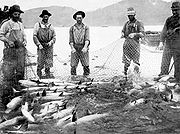
Pacific Salmon Commission
Encyclopedia
The Pacific Salmon Commission is a regulatory body run jointly by the Canadian and United States governments. Its mandate is to protect stocks of the five species of Pacific salmon. Its precursor was the International Pacific Salmon Fisheries Commission, which operated from 1937 to 1985. The PSC enforces the Pacific Salmon Treaty, ratified by Canada and the U.S. in 1985.
 The first commercial salmon fisheries in the Pacific Northwest
The first commercial salmon fisheries in the Pacific Northwest
were started in the early 1800s. Lucrative fisheries were established on the Columbia
and Fraser
rivers, including canneries geared for export. Harvests increased year-to-year until the 1910s. The abundance of the resource had precluded any disagreements between the Canadian and American governments until this point.
However, from the 1920s onward, stocks began to decline, a result of over-fishing and the degradation and obstruction of migratory rivers. Competition between American and Canadian fisheries for the dwindling resource led to conflict. Disputes were complicated by the fact that the salmon crossed several international borders during their lifespan. In 1930, the governments met and proposed the Fraser River Convention to regulate fishing and mitigate environmental damage to salmon habitats. The International Pacific Salmon Fisheries Commission was formally founded in 1937.
. Three obstacles were identified - the Hell's Gate portion of the Fraser Canyon
(where a landslide in 1913 caused by railway engineers had partially blocked the river), the Quesnel River
splash dam, and the Adams River
splash dam. During the 1940s, fish ladders and spillways were constructed by the Commission at Hell's Gate. The splash dams on the Quesnel and Adams were dynamited and removed.
Origins

Pacific Northwest
The Pacific Northwest is a region in northwestern North America, bounded by the Pacific Ocean to the west and, loosely, by the Rocky Mountains on the east. Definitions of the region vary and there is no commonly agreed upon boundary, even among Pacific Northwesterners. A common concept of the...
were started in the early 1800s. Lucrative fisheries were established on the Columbia
Columbia River
The Columbia River is the largest river in the Pacific Northwest region of North America. The river rises in the Rocky Mountains of British Columbia, Canada, flows northwest and then south into the U.S. state of Washington, then turns west to form most of the border between Washington and the state...
and Fraser
Fraser River
The Fraser River is the longest river within British Columbia, Canada, rising at Fraser Pass near Mount Robson in the Rocky Mountains and flowing for , into the Strait of Georgia at the city of Vancouver. It is the tenth longest river in Canada...
rivers, including canneries geared for export. Harvests increased year-to-year until the 1910s. The abundance of the resource had precluded any disagreements between the Canadian and American governments until this point.
However, from the 1920s onward, stocks began to decline, a result of over-fishing and the degradation and obstruction of migratory rivers. Competition between American and Canadian fisheries for the dwindling resource led to conflict. Disputes were complicated by the fact that the salmon crossed several international borders during their lifespan. In 1930, the governments met and proposed the Fraser River Convention to regulate fishing and mitigate environmental damage to salmon habitats. The International Pacific Salmon Fisheries Commission was formally founded in 1937.
IPSFC
The early focus of the IPSFC was to restore the Fraser runs of sockeye salmonSockeye salmon
Sockeye salmon , also called red salmon or blueback salmon in the USA, is an anadromous species of salmon found in the Northern Pacific Ocean and rivers discharging into it...
. Three obstacles were identified - the Hell's Gate portion of the Fraser Canyon
Fraser Canyon
The Fraser Canyon is an 84 km landform of the Fraser River where it descends rapidly through narrow rock gorges in the Coast Mountains en route from the Interior Plateau of British Columbia to the Fraser Valley...
(where a landslide in 1913 caused by railway engineers had partially blocked the river), the Quesnel River
Quesnel River
The Quesnel River is a major tributary of the Fraser River in the Cariboo District of central British Columbia. It begins at the outflow of Quesnel Lake, at the town of Likely and flows for about northwest to its confluence with the Fraser at the city of Quesnel.- History :Just downstream from...
splash dam, and the Adams River
Adams River (British Columbia)
The Adams River is a tributary of the Fraser River in British Columbia, Canada. Beginning in the Monashee Mountains to the north, the Upper Adams River flows mainly southward and eventually reaches Adams Lake. The Lower Adams River begins at the southern end of the lake and flows into the extreme...
splash dam. During the 1940s, fish ladders and spillways were constructed by the Commission at Hell's Gate. The splash dams on the Quesnel and Adams were dynamited and removed.

